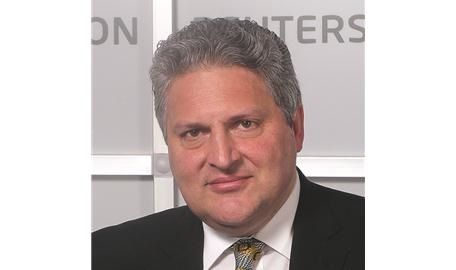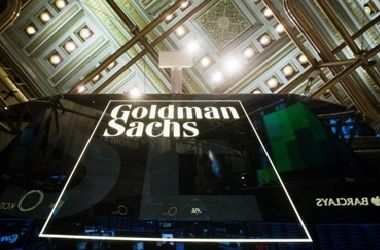Something is afoot at Goldman Sachs. That much is obvious. You just get a distinct sense the succession race that has been one of the most captivating talking points around the market for years, and a constant of Wall Street dinner parties the world over, is accelerating.
I doubt we’ll ever know for certain whether Michael Sherwood’s decision to retire was his alone. And whether:
a) he took one for the team and walked the plank over the firm’s relationship with Philip Green;
b) he felt his chances of succeeding chairman and CEO Lloyd Blankfein had become so slim that waiting around to see what happened was simply no longer worth the effort;
c) this was just the latest chapter in a planned and timed generational shift;
d) Woody just felt it was the right time to get out and focus more time on the Melanie and Michael Sherwood Foundation and his private investments
e) It was a combination of some or all of the above.
Either way, a Goldman legend will be walking out of the door at year-end. The fact he is the third of the firm’s three vice chairmen to announce their retirements in less than 18 months suggests the reason is closer to option c. That this is no coincidence and something of a clearing of the upper ranks to make way for new blood.
Remember that Mark Schwartz, vice chairman and chairman of Goldman Sachs Asia-Pacific, said a little over a year ago he would be retiring. His association with the firm, notwithstanding he spent some time away from Goldman, dates back to 1979. And John Weinberg, vice chairman and co-head of IBD, announced his departure mid-last year after 32 years of unbroken service from 1983. He just landed at Evercore as chairman of the board and executive chairman.
But among a series of frank comments to the FT, Sherwood said Goldman chairman and CEO Lloyd Blankfein had spent considerable time trying to dissuade him from leaving, which supports option d. Notwithstanding the reason, the departures of Schwartz, Weinberg and now Sherwood vacate that senior vice chairman echelon in its entirety, giving Blankfein major latitude to effect change.
Might Goldman, at the same time as it figures out its succession, also be tacitly pushing a narrative it is forcing churn in its senior ranks as a lay-up to divert some of the negative headlines it continues to attract? Probably not.
But from dealings with Malaysia’s scandal-ridden investment fund 1MDB; losing US$1.2bn of the Libyan Investment Authority’s money through complex derivative trades; helping Greece massage its declared sovereign debt quantum; to involvement in the sale of UK retailer BHS ahead of its ignominious collapse, Goldman is being put through the wringer.
That the firm either claims innocence or has been found innocent of any wrongdoing vis-à-vis these stories that won’t go away is not the point here. Goldman has just seemed, potentially unfairly, to have been found in a lot of wrong places at a lot of the wrong times around a lot of the wrong stories. If it is seen to be doing something about it, it just might reduce the white noise of criticism.
Second time around
As for Woody, this will be the second time he’s left Goldman Sachs. Those with long-enough memories will recall that in January 1994 he quit as head of Eurobond syndicate along with head of trading Shaun Church to join Swiss private bank Union Bancaire Privée. That move had caused a sharp intake of breath even then, since Woody was developing a reputation as a bit of a syndicate legend. And more to the point, he had just become the firm’s youngest-ever partner.
As the story goes, he took a short holiday and changed his mind. Within a month he was back at Goldman as if nothing had happened, having never taken up the UBP job. (Church, incidentally, stayed at UBP for a couple of years, went on to run his own hedge fund before switching in the early 2000s to work in the non-profit NGO space.) At the time, Michael de Picciotto, head of UBP in London, said the new job would offer Sherwood a better lifestyle and greater opportunities. Looking back, I think it’s fair to say Woody has managed to eke out an OK lifestyle under his own steam at Goldman.
Future leaders
So who might feature as the firm sets course for its future? Goldman’s management committee, the body sitting under the executive officers, numbers 34. Awash with talent and experience, some of its members look like they’re being groomed for greatness – especially seasoned partners who got their golden keys in the 2000s.
For the CEO job, there’s a shortlist. People say it’s only a matter of time before president and COO Gary Cohn gets the nod. That depends, of course, on how long he’s prepared to wait for Blankfein to make his next move. Cohn has been in-waiting for years now, developing statesman-like qualities and going through Goldman charm school to soften his formerly abrasive demeanour. Can you ever get tired of being next in line to run Goldman Sachs, I wonder?
But Cohn is not the only name out there. Harvey Schwartz, of course, got his elevation and was made an executive officer when he took over from David Viniar as CFO in 2013. He’s a preferred candidate for many. He spent almost five years prior to becoming CFO as global co-head of the securities division. Before his time in securities, he co-ran the Americas financing group within IBD. His breadth of experience suggests he’d be on anyone’s shortlist.
Stephen Scherr, partner since 2002, chief strategy officer and CEO of Goldman Sachs Bank USA is discussed in whispered tones around the succession process. Highly fancied, Scherr worked his way up via EM FICC and TMT investment banking; he served as COO of IBD, ran the global financing group and had a spell running Latin America.
The formidable David Solomon, who made partner in 1999, has been co-head of IBD since 2006 and before that ran the financing group, is said to be still in the running.
Other executives are fancied for continued inner-circle status, even if not in the running for the top job. They include Richard Gnodde, Goldman’s Noddy to Sherwood’s Woody, who gets to run Goldman Sachs International on his own now. A partner since 1998 and an M&A man, he is also co-head of IBD, along with Solomon and John Waldron.
James Esposito, chief strategy officer for the securities division, global co-head of FICC sales, previously co-head of the global financing group and partner since 2006 is highly regarded. As are Marc Nachmann, partner since 2004, head of the global financing group and head of Latin America; the aforementioned John Waldron, co-head of IBD, partner since 2002 who got his most recent role when John Weinberg left; and Gregg Lemkau, co-head of M&A and also partner since 2002.
And given the sales and trading business reported net revenues of US$10.87bn at the nine-month stage compared with US$4.8bn for investment banking, you can’t discount the co-heads of securities on your list of people with prospects. That means Isabelle Ealet, partner since 2000 and previously head of commodity trading, areas where Blankfein and Cohn cut their teeth; Pablo Salame, also partner since 2000; and Ashok Varadhan, who made partner in 2002.
That’s a formidable and long list of seasoned execs. Where some firms have a problem with succession because there isn’t really anyone on the payroll to ace the succession, Goldman has the opposite problem: a deep bench of talent bound by a strong cohesive culture. Such a nice problem to have.

